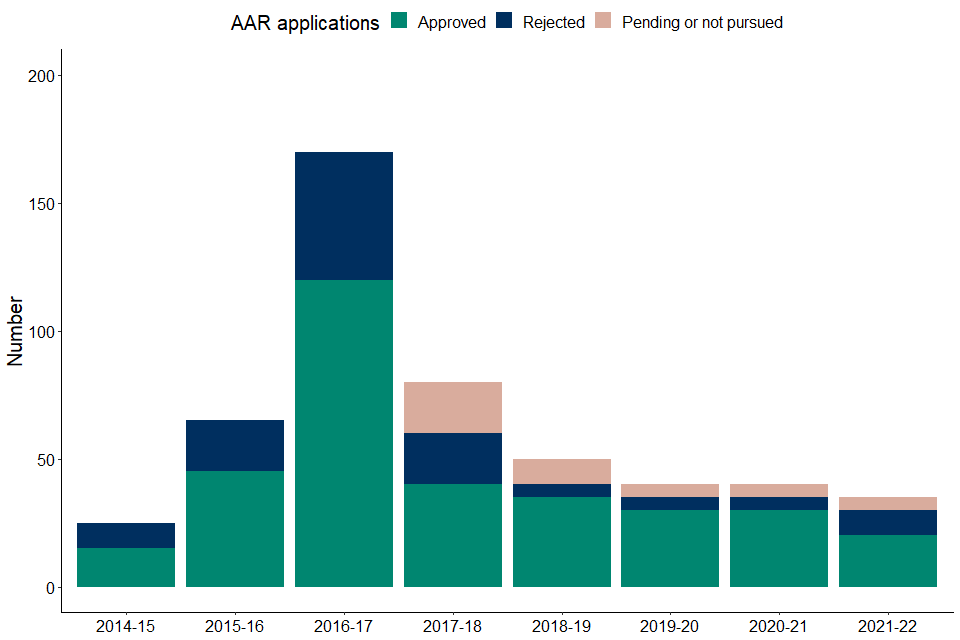Enterprise Investment Scheme, Seed Enterprise Investment Scheme and Social Investment Tax Relief statistics: 2022
Published 5 May 2022
1. Main points and summary
1.1 Enterprise Investment Scheme
-
In 2020 to 2021, 3,755 companies raised a total of £1,658 million of funds under the EIS scheme. Funding has decreased by 12% from 2019 to 2020, when 4,165 companies raised £1,890 million.
-
As the Covid-19 pandemic impacted the UK economy, EIS investment across the first 3 quarters of 2020 to 2021 remained below the level seen across the same quarters of 2019 to 2020. However, in the last quarter of 2020 to 2021 EIS investment rebounded above the last quarter of 2019 to 2020.
-
Around £358 million of investment was raised by 1,370 new EIS companies in 2020 to 2021.
-
In 2020 to 2021, companies from the Information and Communication sector accounted for £571 million of investment (34% of all EIS investment).
-
Companies registered in London and the South East accounted for the largest proportion of investment, raising £1,078 million (65% of all EIS investment) in 2020 to 2021.
1.2 Seed Enterprise Investment Scheme
-
In 2020 to 2021, 2,065 companies raised a total of £175 million of funds under the SEIS scheme. Funding has slightly increased by 4% from 2019 to 2020 when 2,070 companies raised £169 million.
-
Around 1,660 of the companies were raising funds under the SEIS scheme for the first time in 2020 to 2021, representing £154 million of investment.
-
In 2020 to 2021, companies from the Information and Communication sector accounted for £72 million (41% of all SEIS investment).
-
Companies registered in London and the South East accounted for the largest proportion of investment, raising £120 million (68% of SEIS investment) in 2020 to 2021.
1.3 Social Investment Tax Relief
- In 2020 to 2021, 35 social enterprises received investment through the Social Investment Tax Relief (SITR) scheme, and £3.7 million of funds were raised. Funding has slightly increased from 2019 to 2020, when 35 enterprises raised £3 million.
1.4 Advance assurance requests
EIS
- In 2021 to 2022, 3,455 AAR applications for EIS were received and 2,510 (73%) have been approved so far. The number of applications has increased from 2020 to 2021 when 3,080 AAR applications were received and 2,380 (77%) approved.
SEIS
- In 2021 to 2022, 2,750 AAR applications for SEIS were received and 1,970 (72%) have been approved so far. The number of applications has decreased from 2020 to 2021, when 2,780 AAR applications were received and 2,245 (81%) approved.
SITR
- In 2021 to 2022, 40 AAR applications for SITR were received, and 20 (55%) have been approved so far. The number of applications has remained consistent from 2020 to 2021 when 40 AAR applications were received and 30 (72%) approved.
2. Introduction
2.1 About these statistics
This is a National Statistics publication produced by HM Revenue and Customs (HMRC). It provides information on the number of companies raising funds, the number of subscriptions and the amounts raised through the Enterprise Investment Scheme (EIS) and Seed Enterprise Investment Scheme (SEIS).
It also includes Official Statistics on social enterprises raising funds through the Social Investment Tax Relief (SITR) scheme. The EIS, SEIS and SITR are 3 of 4 tax-based venture capital schemes, the other being the Venture Capital Trust (VCT) scheme.
The current release includes the first estimates for 2020 to 2021. The figures for 2018 to 2019 and 2019 to 2020 include small revisions and minor updates, arising from the receipt of a small number of further EIS1 and SEIS1 forms for these years.
Companies have a period of 3 years after shares are issued to submit a compliance statement. Figures from 2019 to 2020 onwards have been uplifted to take account of late returns submitted by companies. Thus, these figures should be treated as provisional and will be subject to revisions in future publications.
The publication also provides information on the industrial and geographical breakdown of EIS and SEIS companies, the distribution of companies by the amounts of funds raised, and the distribution of investors by the size of their investment.
Section 1 summarises the main statistical points; Sections 3, 4, and 5 presents an overview of the statistics and discusses recent trends. In Section 6, this release includes figures for advance assurance requests received by HMRC. As part of the qualifying process for seeking investment through the schemes, companies can provide a return to HMRC in advance of a share issue to check that it will meet the qualifying conditions for these conditions for these schemes.
The statistical tables are included on the main publication page.
The next release is planned to be in Spring 2023.
People interested in this publication may also be interested in the National Statistics publication on Venture Capital Trusts (VCT).
3. Enterprise Investment Scheme (EIS)
3.1 EIS: Number of EIS companies and amount of investment
The number of companies raising funds and the level of investment have shown similar trends since the EIS was introduced. In 2020 to 2021 the number of companies raising funds decreased to 3,755, raising a total of £1,658 million.
By large, there had been a steady increase in EIS use since 2010, which could be due to sustained historically low interest rates, increasing promotion and involvement of fund managers.
In addition, the increase in Income Tax relief from 20% to 30% in 2011 to 2012 and the introduction of the Feed in Tariffs (FIT) initiative from April 2010 (resulting in large amounts of investment into the renewable energy sector) both attracted EIS investment. In 2012 to 2013, most trades attracting FIT were excluded from eligibility for the EIS and most companies benefiting from alternative Department for Energy and Climate Change (DECC) subsidies were excluded from July 2014.
The increase in the annual EIS investment limit for companies from £2 million to £5 million from April 2012 attracted significant investment. The amount of funds raised almost doubled in the tax years ending 2013 to 2015. Subsidised energy activities were progressively excluded from eligibility for the EIS from April 2015, and all energy activities were excluded from April 2016.
Further limits on eligible companies were introduced from November 2015, including age limits and funding limits, and a new growth and development requirement. Despite these measures, investment in the EIS continued to increase up to 2017 to 2018.
As part of the government’s Patient Capital Review, a new risk-to-capital condition was introduced in 2018. This was intended to remove investment arrangements based on capital preservation and ensure that the EIS and other tax-advantaged venture capital schemes are focused on investment in early-stage companies that have the intention to grow and develop in the longer term.
The figures for 2018 to 2019 suggest a small decrease in the amount of EIS investment compared to the previous year which may be as a result of the introduction of the new condition.
The data for 2018 to 2019 onwards include investment in knowledge intensive companies (KICs). Companies that qualify as knowledge intensive (KI) at the time of share issue can make use of increased annual and lifetime funding limits, £10 million and £20 million respectively, and these KICs can receive their first EIS or other risk finance investment up to 10 years from first commercial sale, as opposed to the normal limit of 7 years.
These rules were first introduced in November 2015 and further extended in April 2018. The combination of these increased limits and the focus on growth of the risk-to-capital measure is expected to result in more funds being raised through the EIS in future years in these innovative companies.
In 2020 to 2021, there was a decrease in the number of companies raising funds under the EIS (10%), with the amount raised by EIS companies also dropping by 12% compared to the previous year. The Covid-19 pandemic is likely to have reduced investment through the first 3 quarters of tax year 2020 to 2021. However funding rebounded above pre-pandemic levels in the last quarter of 2020 to 2021.
Figure 1: Number of companies raising funds and amount raised, 1993-94 to 2020-21

3.2 EIS: New investment
The proportion of investment into new companies compared to that for companies raising further funding has declined since the peaks in 2011 to 2012 and 2014 to 2015. This coincides with the investment in renewable energy and the progressive exclusion of these activities from the EIS, as noted above.
In 2018 to 2019, there was a large drop in funds raised by new companies with only 28% of funding being raised by companies using the EIS for the first time. This trend has continued with 22% of the total amount being raised by new EIS companies in 2020 to 2021. This is likely to be due to the introduction of the risk-to-capital condition which places further restrictions on the qualification of investment under the EIS.
These restrictions were introduced to ensure that investment under the EIS is genuinely at risk and is made with the intention of providing long-term growth and development of the company’s trade. Those low-risk and limited growth investment arrangements targeted by the new condition typically involved the creation of new companies raising funds for the first time.
A proportion of this investment was expected to be reinvested elsewhere and, with the new incentives to invest in knowledge intensive companies, this has resulted in increased investment in these companies.
Figure 2: Amount of funds raised under the EIS by new companies and old companies, 1993-94 to 2020-21

3.3 EIS: Industry Sector
In 2020 to 2021, companies from top 4 sectors (the Manufacturing, the Wholesale and Retail Trade, Repairs, the Information and Communication, the Professional, Scientific and Technical sectors) together accounted for around £1,194 million of investment and made up 71% of all EIS Investment. This has remained consistent from 2019 to 2020.
Figure 3 compares the proportion of investment across sectors, by amount raised under the EIS between 2019 to 2020 and 2020 to 2021. The trends for the 2 years are similar, with an increase in the Professional, Scientific and Technical sector but a decrease in the Financial and Insurance sector.
Figure 3: Comparison between amounts of funds raised under the EIS by different industry sectors, 2019-20 to 2020-21
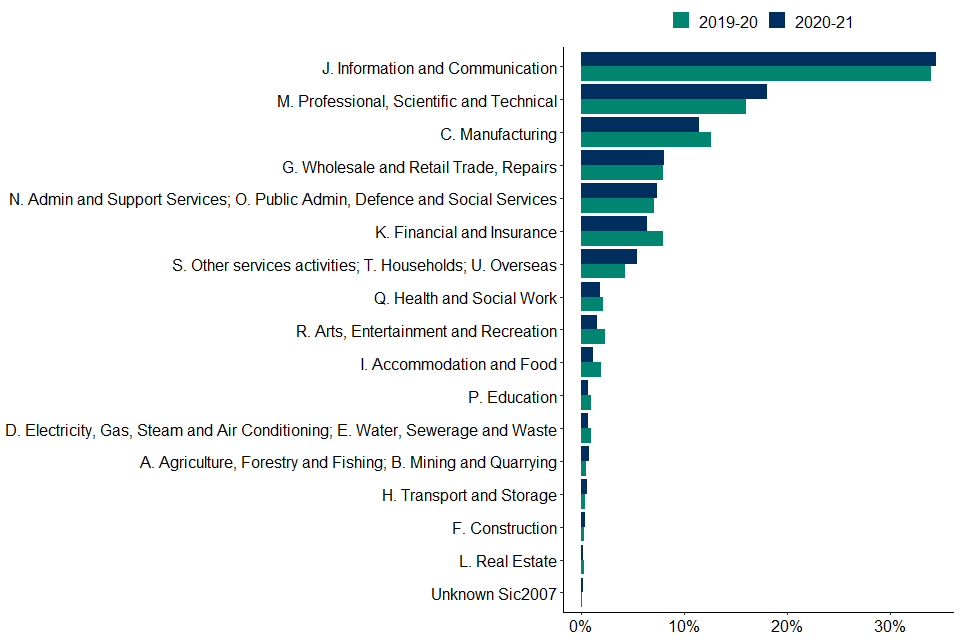
The sector breakdowns in this section are based on the Standard Industrial Classification (SIC) 2007.
3.4 EIS: Size of investment per company
The distribution of the number of companies raising funds under the EIS by investment size differs from the distribution of amount of funds raised by size of investment. In 2020 to 2021, around 4% of EIS companies raised 31% of all investment (investments over £2 million). It is likely that the risk-to-capital condition will have affected these higher investment categories in particular.
Since 2012 to 2013 the annual limit on investment has been £5 million. From 2018 to 2019 onwards this has been increased to £10 million for KICs.
Figure 4: Distribution of the proportion of funds raised under the EIS by investment band, 2020 to 2021

3.5 EIS: Geographical region of company registration
The proportion of the amount of investment in companies with a registered office in London and the South East was 65% in 2020 to 2021. This proportion is similar to recent years.
Figure 5: Distribution of the number of EIS companies and amount of investment by location, 2020 to 2021
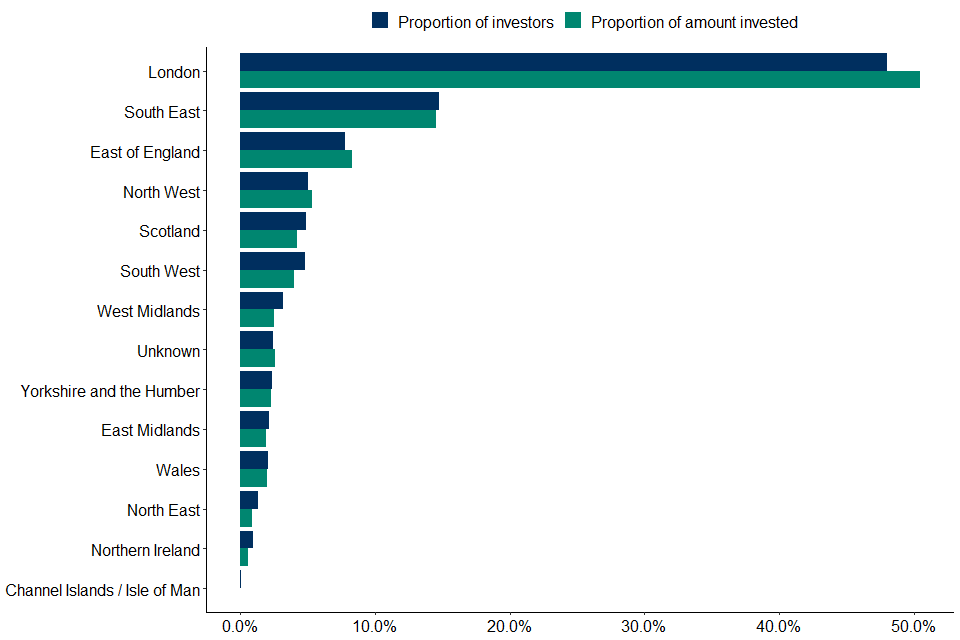
3.6 EIS: Investors claiming Income Tax relief under EIS
The number of investors claiming Income Tax relief on Self Assessment forms under the EIS has increased, from 36,150 in tax year 2019 to 2020 to 37,535 in 2020 to 2021.
The total tax relief claimed under EIS slightly decreased overall in 2020 to 2021, but there was a slight increase in the total number of investors (4%), particularly in the smaller investment size categories (up to £75,000).
In 2018 to 2019, new limits were introduced for investments in KICs. These allow individuals to invest up to £2 million in a year if they are investing in a KIC. There were 40 investments of between £1 million and £2 million in 2020 to 2021, contributing £58 million of investment. With the higher limit available, investments of over £500,000 comprised 16% of the total amount of EIS investment raised on which claims were made in 2020 to 2021.
Figure 6: Proportion of investors and amount of investment, by size of investment (investment on which Income Tax relief was claimed), 2020-21

Total figures provided on the amount of investment on which Income Tax relief was claimed are not directly comparable with the figures on the amount of investment reported by companies. Some investors may choose to offset the tax liability against the previous year. A small amount of relief would also be claimed through the PAYE system; this is assumed to relate to about 5% of total EIS investment.
4. Seed Enterprise Investment Scheme
4.1 SEIS: Number of SEIS companies and amount of investment
In 2020 to 2021, the number of companies raising investment under SEIS remained consistent at 2,065, compared to 2,070 in the previous year. However, the amount raised by these companies slightly increased by 4% to £175 million compared to £169 million in the previous year.
The risk-to-capital condition introduced a requirement for growth and development to the SEIS for the first time in 2018 to 2019, and it is expected that this will have had a short-term impact before the industry adjusted.
Figure 7: Number of companies raising funds and amount raised, 2012-13 to 2020-21
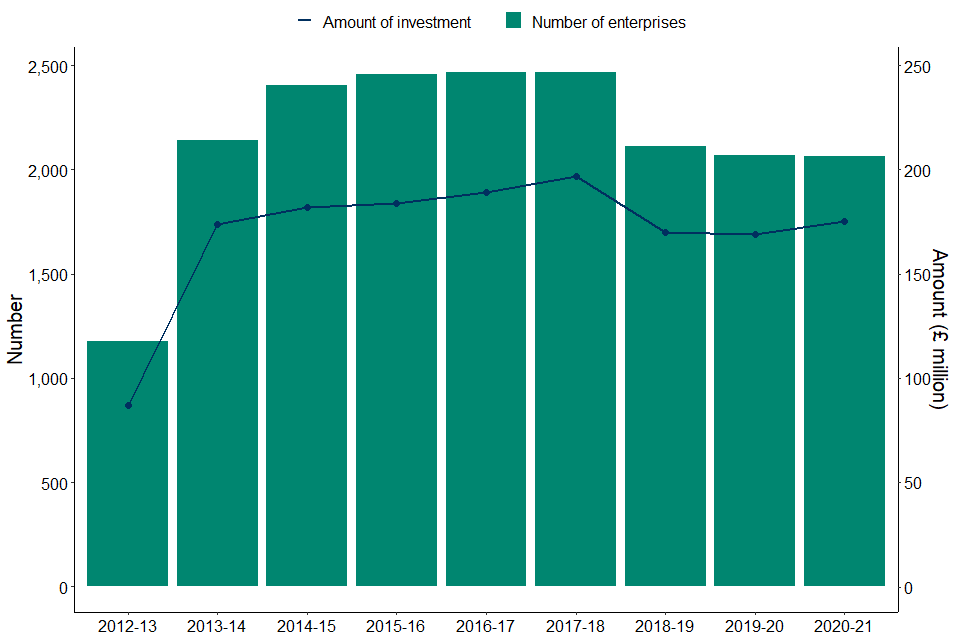
4.2 SEIS: New investment
The number of new companies raising SEIS funds in tax year 2020 to 2021 increased by around 3% from the previous year, and the amount raised by these companies also grew by 6%.
Figure 8: Amount of funds raised by new and old SEIS companies, 2012-13 to 2020-21

4.3 SEIS: Industry sector
In 2020 to 2021, companies from just one sector (the Information and Communication) accounted for £72 million of investment, which makes up 41% of the amount of SEIS investment received. The next 3 largest sectors (the Professional, Scientific and Technical, the Wholesale and Retail Trade, Repairs, the Manufacturing sectors) together account for 32% of investment.
The proportion of SEIS investment by industry sector in 2020 to 2021 has increased in the Information and Communication sector and decreased in the Manufacturing sector, compared to the previous year.
Figure 9: Comparison between the proportion of funds raised under the SEIS by different industry sectors, 2019-20 to 2020-21
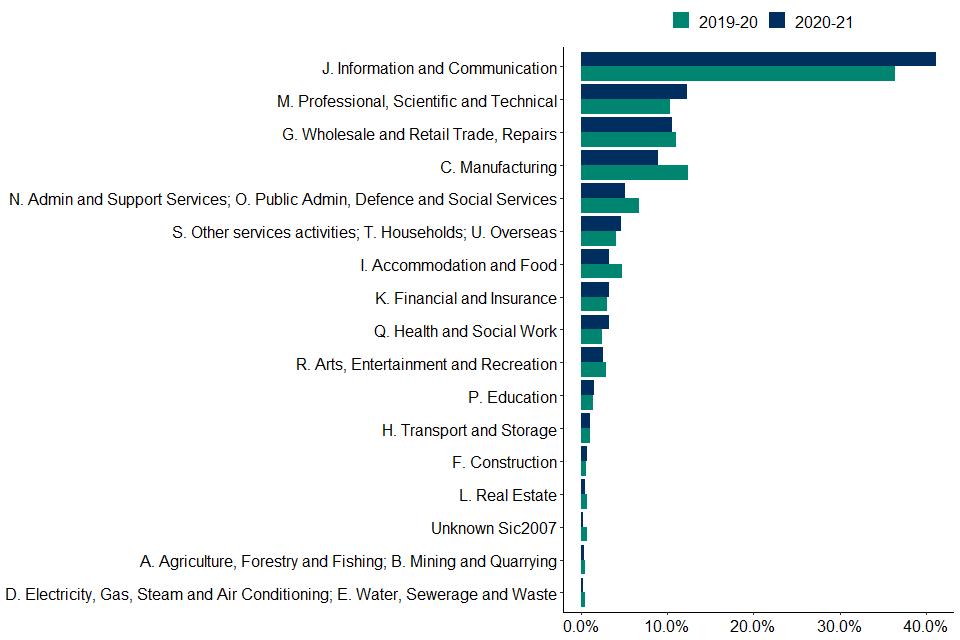
4.4 SEIS: Size of investment per company
Most companies receive investments of over £50,000 through the SEIS (64% in 2020 to 2021). In 2020 to 2021, around 39% of companies raised amounts over £100,000, compared to 36% in 2019 to 2020.
Figure 10: The percentage distribution of funds raised under the SEIS by investment band, 2020-21

4.5 SEIS: Geographical region of company registration
The largest proportion of funds raised under the SEIS were through companies with a registered office in London and the South East. In 2020 to 2021, these regions accounted for 68% of the total SEIS investment (Figure 11), which is slightly higher than the previous year (63%).
Figure 11: The percentage distribution of the number of SEIS companies and amount of investment by location, 2020-21

4.6 SEIS: Investors claiming Income Tax relief under SEIS
In 2020 to 2021, 9,195 investors claimed Income Tax relief on Self Assessment forms for the SEIS, compared to 8,545 investors in 2019 to 2020. The amount of relief claimed also slightly increased by 6% in line with the increase in funds raised by companies in 2020 to 2021.
Most investors claiming the relief invested £10,000 or less into qualifying SEIS companies (59%).
Investments of over £25,000 contributed 59% of the total amount of SEIS investment raised on which claims were made, which is slightly lower than 2019 to 2020 (63%).
Figure 12: Proportion of SEIS investors claiming Income Tax relief and amount of investment by investment band, 2020-21
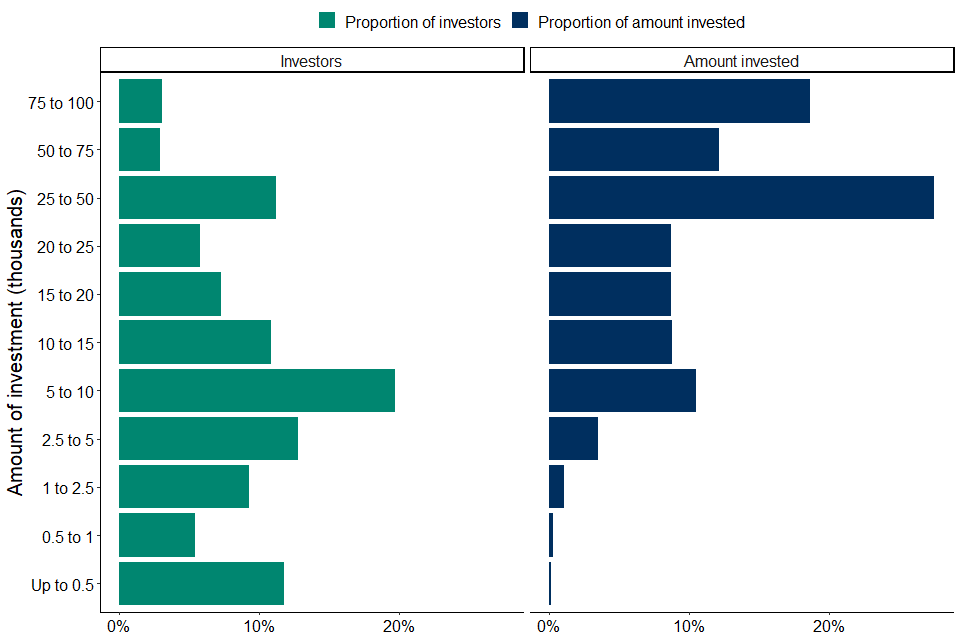
5. Social Investment Tax Relief
5.1 Number of social enterprises and amount of investment
In 2020 to 2021, 35 social enterprises received investment through the Social Investment Tax Relief (SITR) scheme and £3.7 million of funds were raised. Funds are raised through equity investment (shares) and debt investment (loans). Funding has remained consistent with the previous year, where 35 social enterprises raised £3 million.
In 2017, the amount of investment younger qualifying social enterprises could raise through SITR was increased to £1.5 million. At the same time, restrictions on employee numbers and qualifying trades were introduced to make sure the scheme continued to comply with state aid requirements and was well targeted. Among the amendments was the exclusion of activities such as asset leasing, lending, and operating nursing and residential care homes.
Figure 13: Number of companies raising funds and amount raised, 2014-15 to 2020-21
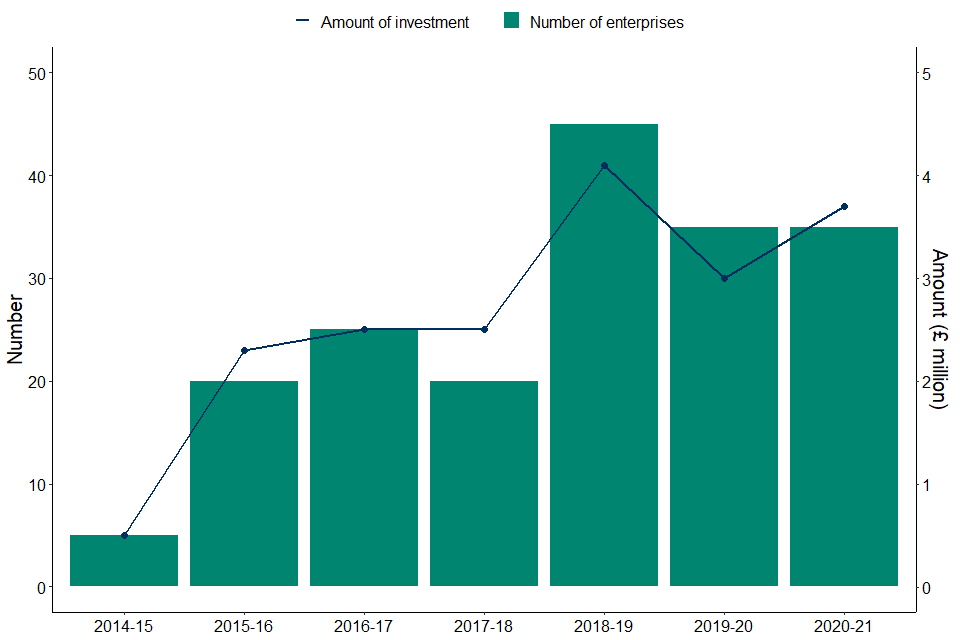
6. Advance assurance requests
Companies considering using the EIS, SEIS or SITR can obtain advance assurance (AA) that HMRC will regard the shares to be issued as satisfying the requirements of the scheme.
These statistics show the number of companies seeking advance assurance, the number of AAR applications received, and, of these, how many were approved, rejected, or not pursued further. Statistics are presented from 2006 to 2007 for the EIS, 2012 to 2013 for the SEIS and 2014 to 2015 for SITR.
6.1 EIS: Number of AARs received and outcomes
In 2021 to 2022, HMRC received 3,455 advance assurance applications for the EIS, an increase of 375 from 2020 to 2021. A number of the applications for 2021 to 2022 are still being processed, but as of March 2022, 73% have been approved so far. Of the 3,080 applications received in 2020 to 2021, 77% have been approved (Figure 14).
Figure 14: Number of EIS advance assurance applications received, approved and rejected, 2006-07 to 2021-22
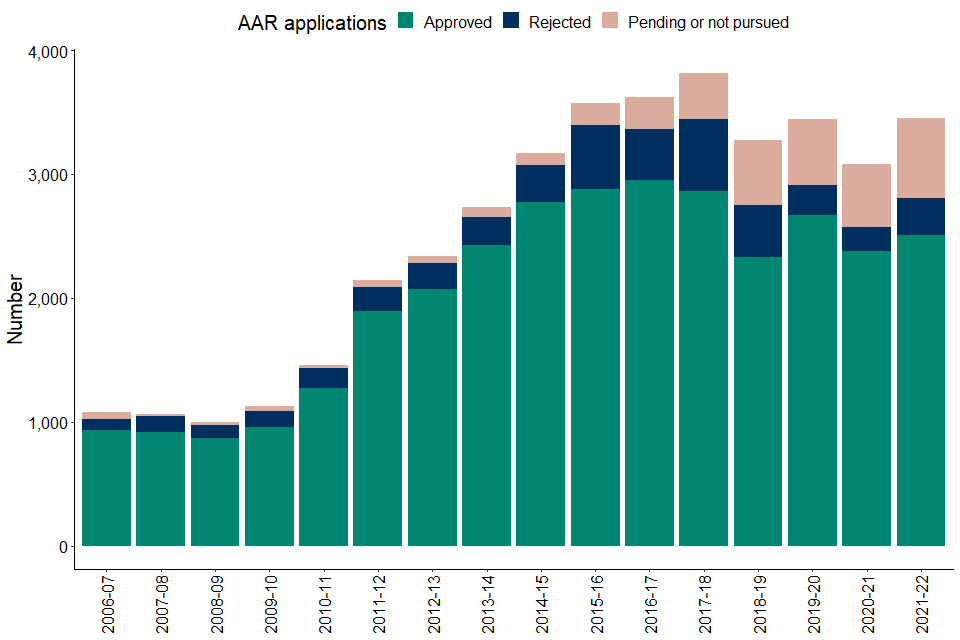
6.2 SEIS: Number of AARs received and outcomes
In 2021 to 2022, HMRC received 2,750 SEIS AAR applications, a decrease of 30 from 2020 to 2021. A number of the applications for 2021 to 2022 are still being processed, but as of March 2022, 72% of applications have been approved. In 2020 to 2021 there were 2,780 SEIS AAR applications and of these 2,245 (81%) have been approved.
Figure 15: Number of SEIS advance assurance applications received, approved and rejected, 2012-13 to 2021-22
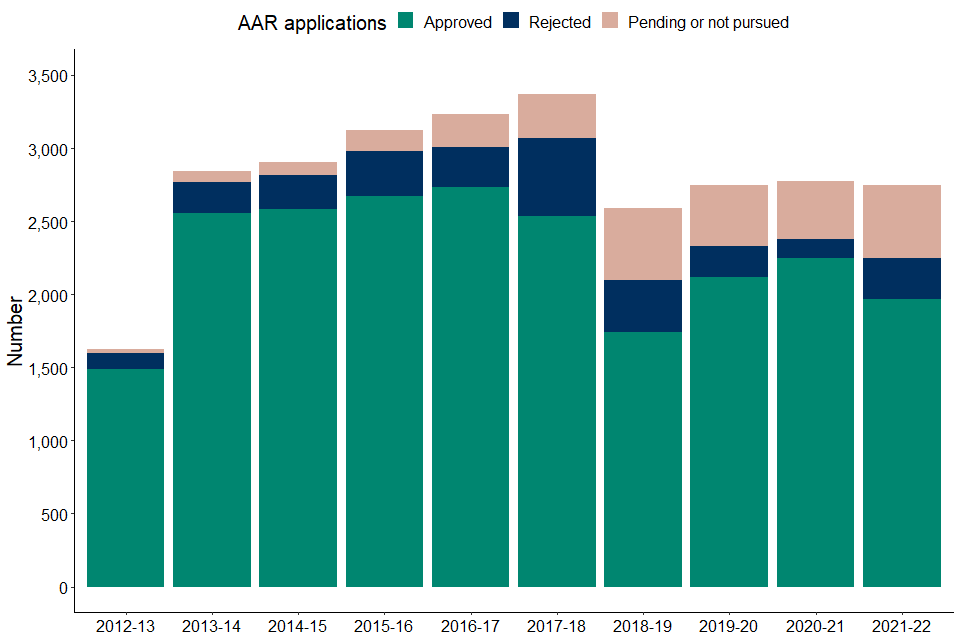
6.3 SITR: Number of AARs received and outcomes
In 2021 to 2022, HMRC received 40 SITR AAR applications. This has remained consistent from 2020 to 2021.
In 2017 to 2018, there was a decrease in the number of AAR applications. The reduction in applications likely reflects changes in the SITR rules which took effect from 6 April 2017.
The changes included an increase in the maximum amount of investment a younger social enterprise may receive at any time, to £1.5 million, subject to a lifetime limit of the same amount. Certain activities such as leasing, energy and on-lending activities were excluded, and anti-abuse provisions were also introduced. As of March 2022, 20 out of 40 applications for 2021 to 2022 have been approved.
In 2020 to 2021, there were 40 SITR AAR applications and, of these 30 (72%) have been approved.
Figure 16: Number of SITR advance assurance applications received, approved and rejected, 2014-15 to 2021-22
